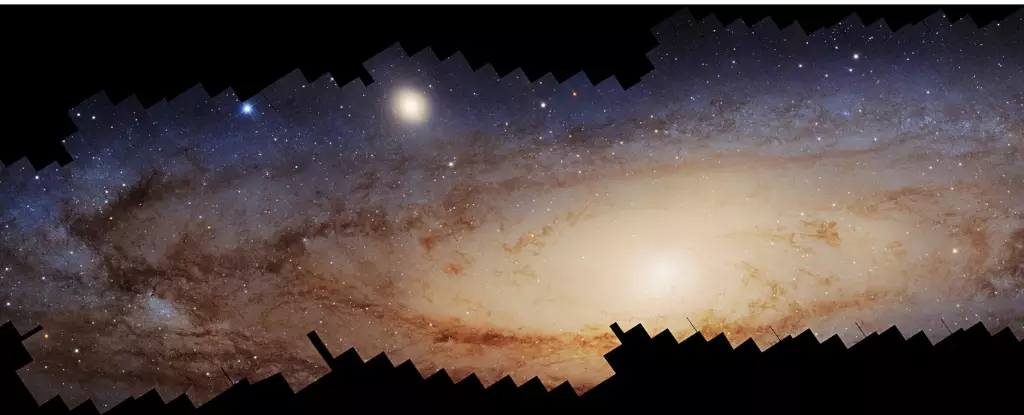The Andromeda Galaxy, or M31, stands as the closest spiral galaxy to our own Milky Way, making it a focal point for astronomical study. Located approximately 2.537 million light-years away, it is not only the nearest large galaxy but also the largest in our Local Group. For most casual observers, Andromeda appears as a faint, blurred smudge in the night sky, barely discernible without optical aid. Yet, despite its subtle appearance, Andromeda holds a wealth of knowledge about galactic formation, structure, and evolution that captivates astronomers across the globe.
To explore Andromeda’s depths, scientists have utilized advanced observational tools, notably the Hubble Space Telescope, which has spent a decade capturing a remarkable 2.5-gigapixel panorama of this fascinating galaxy. This monumental task involved over 1,000 orbits and the collection of hundreds of thousands of images, providing unprecedented detail about Andromeda’s structure, comprising billions of stars, clusters, and cosmic dust lanes. The resulting data not only showcases beautiful stellar landscapes but also serves as an essential comparison point for the Milky Way, allowing astronomers to gain insights into our own galactic home.
Hubble’s observations were part of two major astronomical initiatives, the Panchromatic Hubble Andromeda Treasury (PHAT) and its counterpart, the Panchromatic Hubble Andromeda Southern Treasury (PHAST). These programs combined to deliver vital insights, enabling researchers to chart the composition and dynamics of distinct regions within Andromeda. The capacity to investigate the galaxy holistically can help address fundamental questions about the nature and lifespan of spiral galaxies.
One of the primary benefits of studying Andromeda lies in its clarity. It presents fewer observational challenges compared to more distant galaxies, where light interference from cosmic dust and uncertainty in distance measurements can obscure results. Recent research, published in the Astrophysical Journal, emphasizes how detailed scrutiny of M31’s stars reveals intricate histories of mergers and interactions that have shaped Andromeda. A critical observation from these studies is the marked difference between the galaxy’s northern and southern disks; the latter appears more disturbed, showcasing the scars of past galactic collisions.
Notably, the dwarf galaxy M32 provides a compelling glimpse into Andromeda’s tumultuous past. Astronomers theorize that M32 may be a remnant of a more massive galaxy that succumbed to Andromeda’s gravitational pull a couple of billion years ago. Thus, the examination of structures like M32 contributes valuable data on the merger history of Andromeda, painting a picture of a galaxy undergoing significant transformations.
Astrophysicists frequently describe Andromeda as a “train wreck,” indicative of its violent interactions over cosmic time. The existence of the Giant Southern Stream—a tidal debris trail in Andromeda’s halo—suggests remnants from a historic merger with another galaxy, providing a tangible record of its evolutionary journey. Interestingly, the metallicity (the abundance of elements heavier than helium) of stars within this stream is generally lower than those found in Andromeda’s bulge and disk, indicating a different formation environment.
These findings suggest that Andromeda might be transitioning from a star-forming spiral galaxy into a more evolved elliptical shape filled predominantly with aging stars. This transformation mirrors processes theorized to occur in our own Milky Way, emphasizing why the study of Andromeda is pivotal in understanding galactic evolution broadly.
The quest to unlock the mysteries of the Andromeda Galaxy will gain further momentum with upcoming astronomical missions, notably the expected launch of NASA’s Nancy Grace Roman Space Telescope. This advanced infrared observatory will boast an expansive field of view and the capability to capture high-resolution images that could illuminate even the faintest details of Andromeda’s structures.
As astronomy progresses, the advances in technology promise to deepen our understanding of M31, its past mergers, and its role within the broader cosmos. Through these continued explorations, astronomers hope to decode not just the story of Andromeda but also the fundamental principles governing galaxies across the universe.
The Andromeda Galaxy stands as both a neighbor and a treasure trove of information waiting to be uncovered. Each discovery underscores the intricate nature of cosmic evolution while offering a mirror to reflect upon our own galaxy’s story. As researchers continue to gaze into the depths of Andromeda, they remain hopeful of unraveling the complex narrative of its formation, evolution, and ultimate fate.

